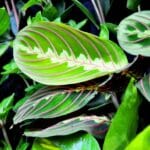Whether you’re already a pro gardener or just starting to appreciate plants, one type of plant that you should probably consider is a cactus. Thanks to their striking appearance, unique forms, and easy-to-care nature, cactus plants quickly make an excellent and decorative way to boost up any dull space in your house or garden.
- Moon Cactus (Gymnocalycium mihanovichii)
- Bunny Ears Cactus (Opuntia microdasys)
- Star Cactus or Sand Dollar Cactus (Astrophytum asterias)
- Old Lady Cactus (Mammillaria hahniana)
- Spiny Pincushion Cactus (Mammillaria spinosissima)
- Feather Cactus (Mammillaria plumosa)
- Golden Barrel Cactuses (Echinocactus grusonii)
- Totem Pole Cactus (Lophocereus schottii var. mostruosa)
- Fairy Castle Cactus (Acanthocereus tetragonus ‘Fairy Castle’)
- Holiday Cacti
- A Few More Cactus Species to Consider Growing
- Parodia Scopa
- Saguaro Cacti
- Silver Ball Cactus
- Rat Tail Cactus
- Indian Fig Cactus (Carnegiea gigantea)
- Mistletoe Cactus
- Epiphytic Cactus
- Walkingstick Cactus
- Euphorbia tirucalli
- Paraodia magnifica
- Lady Finger Cactus Species (Mammillaria elongata)
- Mountain Cactus
- Pineapple Cactus
- Old Man Cactus
- Nipple Cactus
- Hedgehog Cactus
Most cactus plants or cacti are native to the Americas and are drought-tolerant. They are slow-growing and relatively self-sustaining, which makes them suitable as houseplants even for someone lacking a green thumb.

Cacti, which belong in the botanical family Cactaceae, have areoles. These are small bumps along the stems in which the spines grow from.
Areoles are parts of cactus plants that distinguish them from other succulents. For that reason, all types of cactus can be classified as succulents, but not all succulents can be considered as cactus.
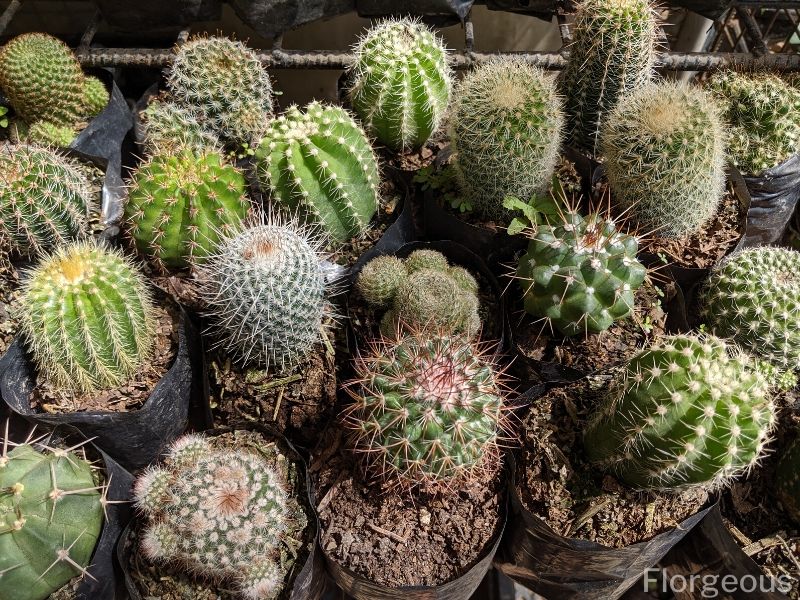
Are you interested to learn more about these unique desert plants? Learn more about the best types of cacti by reading our guide below.
Although cacti are sun-loving plants, they could thrive well indoors, especially with proper care. In fact, cactus houseplants have become so popular that many plant lovers continuously grow their collections with more and more additions of different cactus types.

Not only do they add charm in any living space, but they are also easy to grow and maintain. If you want to learn more about different cactus plants, we’ve summarized below the most popular cactuses.
Moon Cactus (Gymnocalycium mihanovichii)
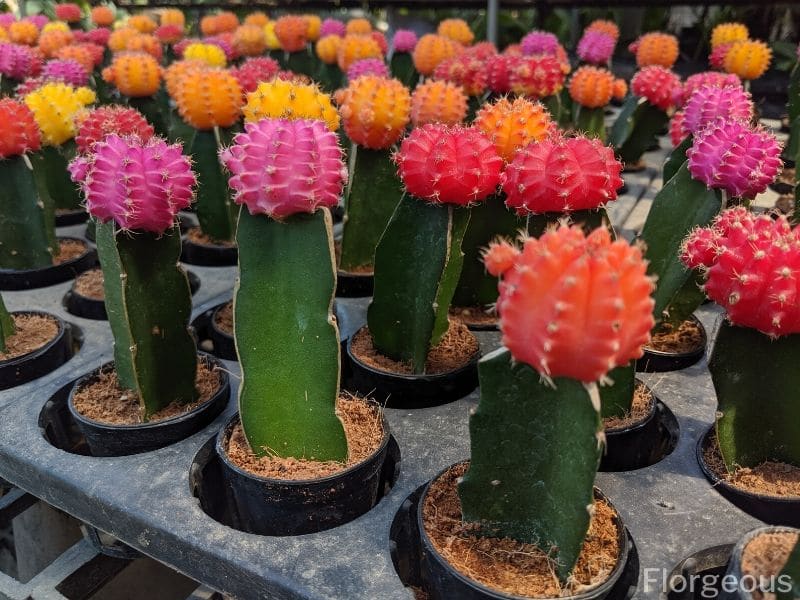
Other common names: Hibotan cactus, chin cactus
Moon cactus plants, known scientifically as Gymnocalycium mihanovichii, are one of the most popular types of cacti for home gardens.
Interestingly, these cacti cannot produce chlorophyll. They need a stock cactus that produces such pigment in which they can be grafted onto for them to thrive well. For that reason, the term “mutant cactus” is a standard reference for these plants.
You’ll quickly recognize them for their vivid neon orange, yellow, purple, red, or pink lollipop-like shapes that sit atop a rootstock cactus, like Hylocereus undatus (1). This type of cactus is native to South America, particularly to desert habitats in the region.
Moon cactus plants can be grown indoors if provided with sufficient light. Classified as small cactus plants, each of these cacti grows only up to 0.5 inches in width. However, some cultivars can grow up to 8 inches in diameter.
Popular cultivars of moon cactus plants:
- Gymnocalycium mihanovichii var. friedrichii ‘Hibotan’
- Gymnocalycium mihanovichii’ Hibotan Nishiki’
- Gymnocalycium mihanovichii var. friedrichii ‘Pink-Kuro’
- Gymnocalycium mihanovichii var. friedrichii ‘Akagurohibotan-Nishiki’
Bunny Ears Cactus (Opuntia microdasys)
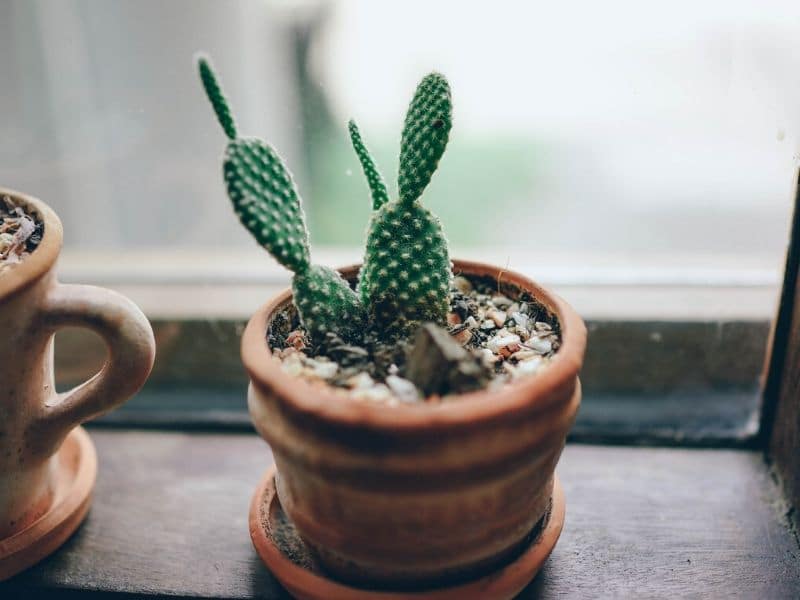
Other common names: polka dot cactus, angel’s wings cactus, neon cactus, golden bristle cactus, bunny cactus
Bunny ear cactus plants wouldn’t be named as such if not for their pairs of pad-like stems that resemble a bunny’s ears. Surely, the interesting appearance of this plant quickly catches a cactus aficionado’s attention, but what makes this desert plant even more appealing is that it requires little to no maintenance.
Known scientifically as Opuntia microdasys, bunny ear cactus plants grow up to 40 to 60 m in height. If planted outdoors, they can grow up to 90 cm (3 ft) tall and 1.8 m (6 ft) wide.
They are clump-forming cacti that do not develop spines. Instead, they feature clusters of white or yellow glochids, with each glochid measuring about 2 to 3 mm long. The yellow flowers are globular and reach up to 3 cm in width (2).
Bunny ear cactus plants are native to central and northern Mexico (2). This type of cactus plant requires a well-drained container, whether planted indoors, but it can also be grown outdoors. Occasional pests include scale insects and mealybugs, which can easily be treated with alcohol-soaked cotton balls.
The genus name Opuntia originated from the Greek word Opus, a place in Greece where cactus-like plants grow. The species name mircrodasys, on the other hand, comes from a Latin word that means small and bushy.
Popular varieties and subspecies of bunny ear cactus plants:
- Opuntia microdasys var. albispina
- Opuntia microdasys var. pallida
- Opuntia microdasys var. pallida f. cristata
- Opuntia microdasys subs. rufida
Star Cactus or Sand Dollar Cactus (Astrophytum asterias)
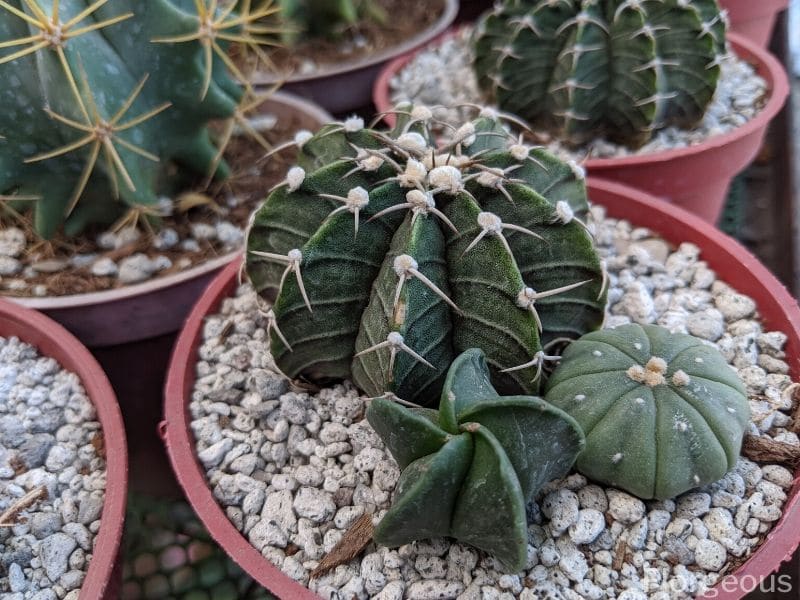
Other common names: sea urchin cactus, star peyote
Astrophytum asterias, or more popularly known as star cactus or sand dollar cactus, is another excellent addition to our list of fascinating cactus plants for home gardens. They are small, spineless, and rounded cacti native to Mexico and small parts of Texas in the United States.
Star cacti are distinguished for their rounded bodies that grow about 2 to 7 cm tall and up to 15 cm in diameter (3). More often than not, they resemble sand dollars, a type of sea urchin, hence the common name. The stem flaunts eight triangular lobes or ridges, which is more evident when viewed from the top.
In spring, these plants grace yellow flowers with contrasting orange to orange-red centers. Each bloom grows up to 15 cm wide, which opens in the morning and closes at night (3). The fruits can be green, pink, or grayish-red and covered with wooly hair.
Popular cultivars of sand dollar cactus plants:
- Astrophytum asterias’ Super Kabuto’
- Astrophytum asterias’ Ooibo Kabuto’
- Astrophytum asterias’ Shinshowa Red’
Old Lady Cactus (Mammillaria hahniana)
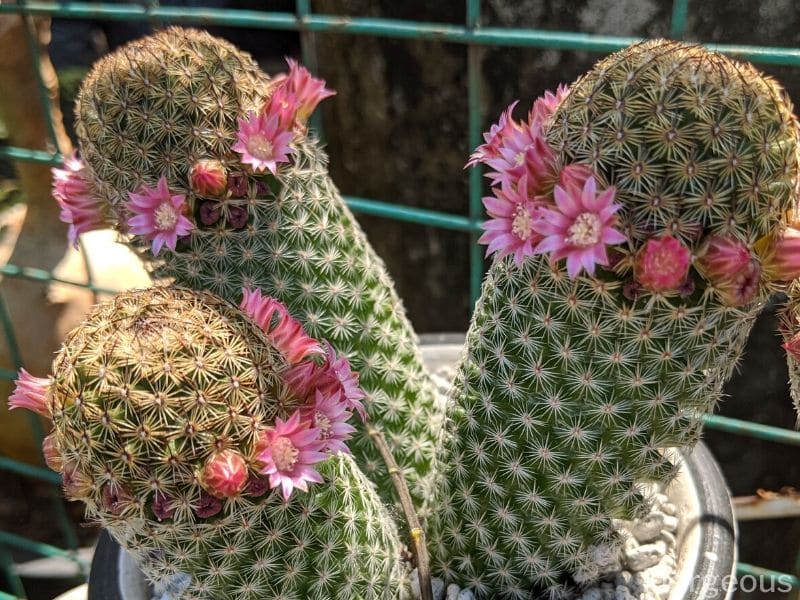
Other common names: Old lady pincushion cactus, birthday cake cactus
Old lady cactus or Mammillaria hahniana is a sun-loving plant under the Mammillaria or pincushion cactus genus. It is native to central Mexico.
The old lady cactus plant is one of the most popular cacti for indoor use, perhaps because of its unique and attractive appearance. Its stem, which flaunts white spines and dense white hairs, grows up to 4 inches in height and 5 inches in width.
Initially, the stem is globular but becomes cylindrical as it matures. The dense white hairs that cover the stem are long, thin, and can increase in thickness and length over time.
Bright reddish-purple flowers that form a crown at the top part of the sphere make this famed succulent readily recognizable. Each flower is about 12 to 15 mm in diameter and blooms in spring and summer.
This cactus plant can be grown both indoors and outdoors and does not require much care and maintenance in general. Note, however, that it is crucial to give it sufficient drainage if you are growing it in a pot since too much moisture could result in root rot.
Popular varieties, subspecies, and forms of old lady cactus plants:
- Mammillaria hahniana f. albiflora – white flowering form
- Mammillaria hahniana var. giselana
- Mammillaria hahniana var. werdermanniana
- Mammillaria hahniana subs. bravoae
- Mammillaria hahniana subs. mendeliana
- Mammillaria hahniana subs. woodsii
Spiny Pincushion Cactus (Mammillaria spinosissima)
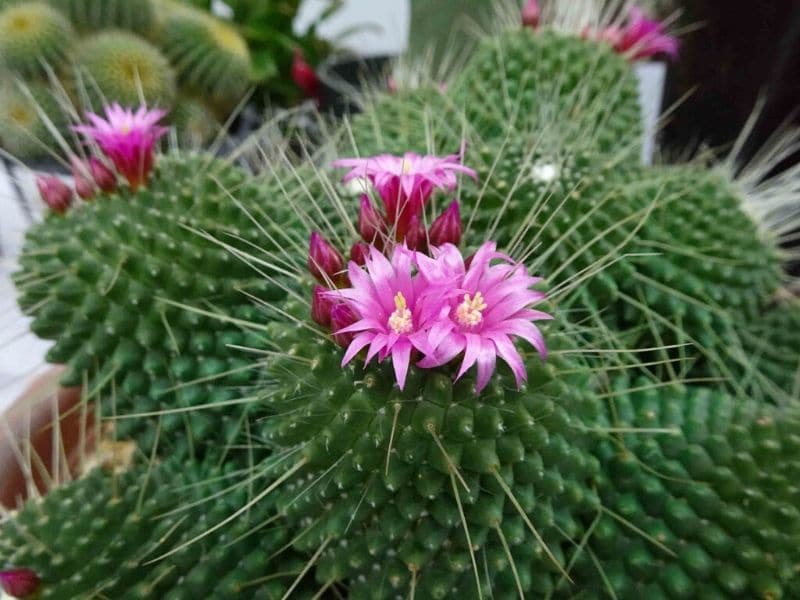
Other common names: red-headed Irishman cactus, Irish red-head cactus
Another well-recognized cactus plant from the Mammillaria genus is the spiny pincushion cactus plant (Mammillaria spinosissima). It is endemic to Mexico, mainly to mountainous areas in Guerrero, Morelos, and Mexico State.
The name “spiny pincushion” originates from the plant’s dense covering of thin, needle-like, red-brown, or white spines that give it a unique appearance among other species in the genus. The stems are dark blue-green, cylindrical, and measure 7 to 30 cm long and 6 to 10 cm in diameter.
With proper care, attractive blooms will furnish in spring. The flowers are purple to deep pink, measuring 12 to 20 mm long and 15 mm across. They form a ring-like structure at the top part of the plant like other Mammillaria cacti.
Popular varieties, subspecies, and forms of spiny pincushion cactus plants:
- Mammillaria spinosissima var. auricoma
- Mammillaria spinosissima var. auricoma f. cristata
- Mammillaria spinosissima ’Un Pico’
- Mammillaria spinosissima var. sanguinea
Feather Cactus (Mammillaria plumosa)

Another common name: golf ball cactus
Mammillaria plumosa, or more popularly known as feather cactus, is a clustering type of cactus that forms a pile of globose stems. The plant grows up to 5 inches tall and 16 inches across, with each stem measuring up to 2.8 inches in diameter.
This cactus plant got its name because of the distinctive white “feathers” that cover the entire stem of the plant. These “feathers” may appear soft and fluffy, but they conceal sharp spines under the surface.
Though the feathery spines make this plant an excellent addition to anyone’s succulent collections and gardens, they help shade the plant from too much heat and sunlight.
The flowers of feather cactus or golf ball cactus vary in colors, which can either be creamy-white, greenish-yellow, or pink, depending on the variety. They bloom in late summer, measuring up to 15 mm long with a strong sweet scent.
The feather cactus plants are native to the northeastern part of Mexico.
A popular variety of feather cactus plants:
- Mammillaria plumosa var. roseiflora
Golden Barrel Cactuses (Echinocactus grusonii)

Other common names: barrel cactus, mother-in-law’s cushion cactus, mother-in-law’s seat cactus, golden ball cactus
Echinocactus grusonii, or commonly recognized as golden barrel cactus, is a popular houseplant distinguished for its globular, barrel-shaped ribbed sole stem lined with prickly golden-yellow spines. Thick, white woolen hairs cover the top part of the plant.
Golden barrel cactus plants are slow-growing and can tolerate low light, which makes them an ideal choice for the indoors. When planted outdoors or in the wild, they can grow up to 130 cm in height and up to 90 cm in width.
The flowers, which are yellow and cup-shaped, are usually found in older plants and a rare occurrence indoors.
These plants are endemic to east-central Mexico.
Popular varieties and forms of golden barrel cactus plants:
- Echinocactus grusonii var. albispina
- Echinocactus grusonii cristata
- Echinocactus grusonii var. curvipinus
- Echinocactus grusonii f. monstruosus
- Echinocactus grusonii var. brevispinus
- Echinocactus grusonii var. brevispinus f. cristata
- Echinocactus grusonii setispinus mostruosus
- Echinocactus grusonii var. intermedius
Totem Pole Cactus (Lophocereus schottii var. mostruosa)
Other common names: totem cactus, monstrous whisker cactus
Totem pole cactus (Lophocereus schottii var. mostruosa) are slow-growing plants that feature tall, slim, and columnar stems that branch at the base. Fully matured plants typically reach a height of 3 to 4 m and a diameter of 10 to 12 cm., but others can reach up to 6 m tall.
Its irregularly shaped ribs with raised, knob-like swellings along the stems and few spines give this cactus plant a unique appearance. It boasts pink flowers but are rarely seen.
Totem pole cactus plants are resistant to drought. They require full sun, though they can tolerate partial shade or shade as well. This unique cactus is native to Arizona and northwestern Mexico.
Fairy Castle Cactus (Acanthocereus tetragonus ‘Fairy Castle’)
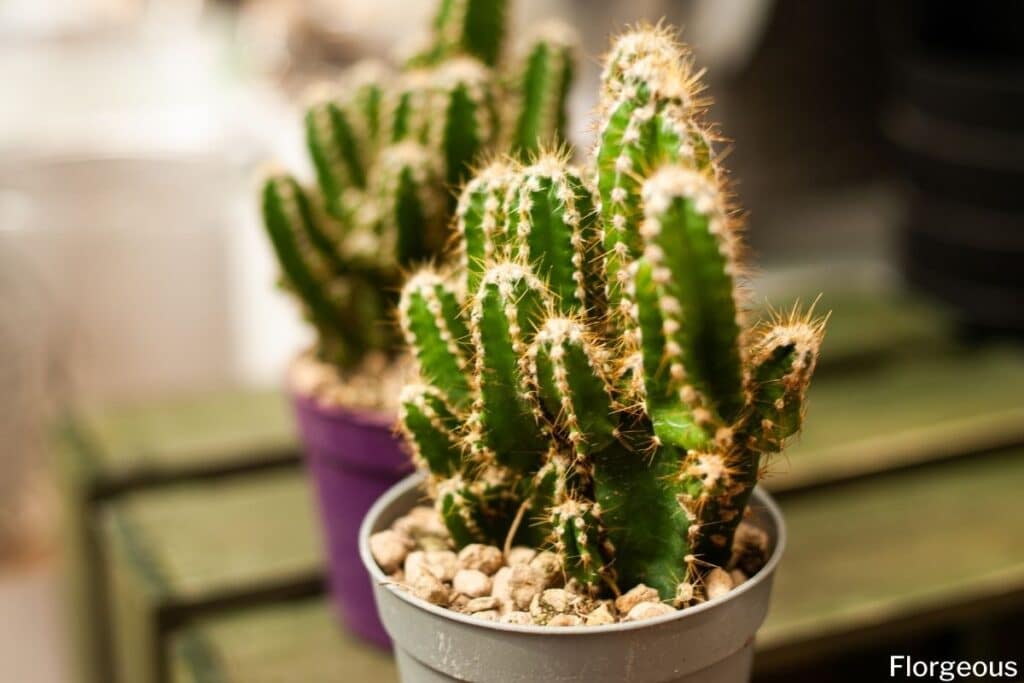
Other common names: fairytale castle cactus, green finger cactus
Fairy castle cactus, otherwise known as Acanthocereus tetragonus ‘Fairy Castle’ or formerly Cereus tetragonus ‘Fairy Castle,’ is a columnar cactus native to North America, Central America, the Caribbean, and northern South America.
A favorite of many cactus enthusiasts because of its unique form, it features many branches and branchlets in different heights that resemble turrets and spires, hence the name. The main stem has five sides and features short, creamy white, and bristle-like spines along the ribs.
The fairy castle cactus plant is slow-growing. A mature cactus plant can reach up to 3.3 ft in height. It rarely blooms, but when it does, it showcases white or yellow flowers.
Holiday Cacti

Holiday cacti are popular houseplants that deliver attractive blooms in shades of pink, white, and red. Named after the holiday season in which they showcase their beautiful flowers, these holiday cacti are named as Thanksgiving cactus, Christmas cactus, and Easter cactus.
People sometimes get confused between Thanksgiving cactus and Christmas cactus because of their close resemblance as they both belong in the Schlumbergera genus. However, it’s quite easy to distinguish when you look at their bloom time and the shape of their stem segments.
Read on to know more about these two types of holiday cacti, as well as the Easter cactus plant.
Thanksgiving Cactus (Schlumbergera truncata)
Other common names: crab cactus, false Christmas cactus, holiday cactus
Thanksgiving cactus or Schlumbergera truncata plants are native to the tropical forests of Brazil. Often confused with the Christmas cactus (S. bridgesii), this holiday cactus blooms earlier, around the Thanksgiving holiday.
Sometimes referred to as crab cactus, this outdoor plant features tubular-shaped flowers and leaf-like stem segments with sharp serrated edges. The flowers can be red, pink, purple, or white, depending on the variety. Each plant can grow up to 12 inches in height and up to 24 inches in spread.
Christmas Cactus (Schlumbergera bridgesii)
Other common names: holiday cactus
Although the Christmas cactus (Schlumbergera bridgesii) may initially look the same as its parent plant, the Thanksgiving cactus, the shapes of their stem segments tell the main difference.
Unlike Thanksgiving cactus with serrated edges, Christmas cactus flaunts flattened stem segments with rounded margins. The flowers are tubular-shaped and often come in vibrant red or fuchsia pink colors.
Also, S. bridgesii blooms later than the Thanksgiving cactus. It typically showcases its beautiful flowers in the late winter or during the Christmas season. The plant can grow up to 10 inches in height and up to 24 inches in width.
Christmas cactus plants are native to the southeastern part of Brazil, particularly to the coastal mountains in the area.
Easter Cactus (Rhipsalidopsis gaertneri)

Other common names: spring cactus, Whitsun cactus, holiday cactus
Easter cactus (Rhipsalidopsis gaertneri), or otherwise known as Hatiora gaertneri, is a perennial cactus that can grow up to 25 inches or 63 cm in height and up to 30 to 40 cm in diameter.
As with the other holiday cacti, the Easter cactus is endemic to southeastern Brazil. It flaunts flattened stems that are divided into oblong or elliptic segments with smooth edges and small, soft hairs in between.
These leaf segments are pale green and darken in color as they age. Each segment can grow up to 3 inches long and 1 inch wide.
The flowers, which usually measure 4 to 5 cm long and 4 to 7.5 in diameter, bloom in the late winter or early spring. The flowers of Easter cactus are broader than those of the Thanksgiving cactus and Christmas cactus. The color ranges from crimson red to white, lavender, and oranges, depending on the variety.
A Few More Cactus Species to Consider Growing
Are you looking for some other cacti? While the cacti plants listed above are some of the most popular species for beginner growers, there are plenty of other options for cactus collectors to consider. Let’s keep going!
Parodia Scopa
One popular species is the Parodia Scopa, also known as the Ball Cactus. This small, round cactus is covered in yellow bristles, making it an eye-catching addition to any collection. It’s native to Argentina and blooms in the summer with vibrant, yellow flowers.
Saguaro Cacti
Another well-known cactus is the Saguaro. These spiny giants can grow up to 40 feet tall and are native to the Sonoran Desert in the southwestern United States and Mexico. They’re slow to grow and can take up to 75 years to develop their first arm. Saguaro cacti are also known for their role in Native American culture, as they symbolize strength and endurance.
Silver Ball Cactus
If you’re looking for a smaller cactus, the Silver Ball Cactus might be for you. As its name suggests, this cactus has silver-grey spines and a round shape. It’s relatively easy to care for and blooms with pink or yellow flowers in the summer.
Rat Tail Cactus
For something a little more unusual, you might consider the Rat Tail Cactus. This cactus gets its name from its long, thin stems that resemble a rat’s tail. It’s native to South America and blooms with bright pink flowers in the summer.
Indian Fig Cactus (Carnegiea gigantea)
The Indian Fig Cactus, also known as the Prickly Pear, is a versatile species with edible fruit and pads that have been used in traditional medicine for centuries. It’s native to North and South America and blooms with vibrant yellow or orange flowers in the spring.
Mistletoe Cactus
For a truly unique cactus, try growing the Mistletoe Cactus. This species has long, thin stems that cascade down, giving it a hanging, vine-like appearance. It’s native to Mexico and blooms with white or pink flowers in the winter.
Epiphytic Cactus
Then there’s the Epiphytic Cactus, also known as the Christmas Cactus. This cactus gets its name from its tendency to bloom around the holiday season. It has flat, segmented stems with delicate spikes and comes in a variety of colors, including pink, white, and red.
Walkingstick Cactus
The Walkingstick Cactus gets its name from its long, thin stems that resemble walking sticks. This cactus can grow up to 13 feet tall and produces beautiful pink flowers.
Euphorbia tirucalli
Euphorbia tirucalli, also known as the Firestick Cactus or Pencil Cactus, is a unique cactus that has green stems that turn bright red in the sun. It’s native to Africa and can grow up to 30 feet tall.
Paraodia magnifica
Paraodia magnifica, or the Balloon Cactus, has a distinctive round shape that makes it stand out from other cacti. It’s native to South America and produces bright yellow flowers.
Lady Finger Cactus Species (Mammillaria elongata)
Lady Finger Cactus is a group of cacti that have long, thin stems that resemble fingers. They’re native to Mexico and produce beautiful pink flowers.
Mountain Cactus
Mountain Cactus, also known as the Snowball Cactus, is a small and spiny cactus that gets its name from the cotton-like material it produces on its stems. It’s native to the Andes Mountains in South America.
Pineapple Cactus
Pineapple Cactus, also known as the Strawberry Cactus, gets its name from the small fruit it produces that resembles a pineapple. It’s native to the southwestern United States and Mexico.
Old Man Cactus
Old Man Cactus gets its name from the long, white hairs that cover its stems, giving it the appearance of an old man’s beard. It’s native to Mexico and produces yellow flowers.
Nipple Cactus
Nipple Cactus, also known as Notocactus scopa, is a small and spiny cactus that produces yellow flowers. It’s native to Argentina and Uruguay.
Hedgehog Cactus
Hedgehog Cactus is a group of cacti that have spiny stems and produce beautiful pink flowers. They’re native to the southwestern United States and Mexico.
Finally, if you already own some of these cacti at home and looking to expand your collection, make sure to learn these propagating succulents tips.
References
Reference List:
- Grafted Cactus, Neon Cacti, Moon Cactus, Hibotan Cactus. (2020). Grafted Cactus, Neon Cacti, Moon Cactus, Hibotan Cactus. [online] Available at: https://www.uaex.edu/yard-garden/resource-library/plant-week/Grafted-Cactus-Neon-Cacti-Moon-Cactus-Hibotan-Cactus-11-27-2015.aspx
- Daf.qld.gov.au. (2020). [online] Available at: https://www.daf.qld.gov.au/__data/assets/pdf_file/0005/137048/IPA-Bunny-ears.pdf
- Fws.gov. (2020). [online] Available at: https://www.fws.gov/southwest/es/Documents/R2ES/Star_Cactus_5-yr_Review_FINAL_June2013.pdf
Close







